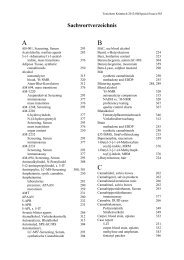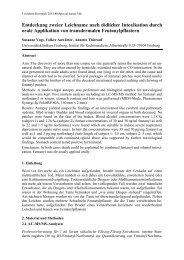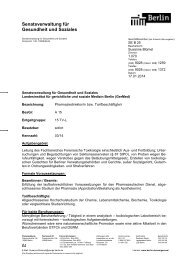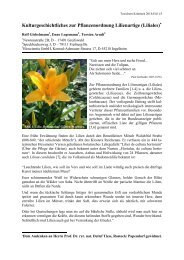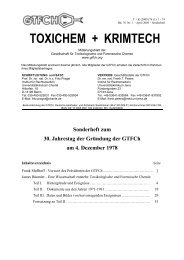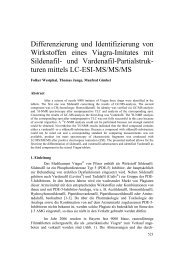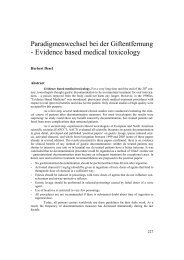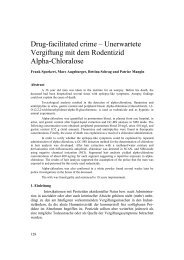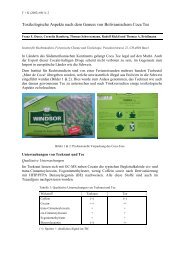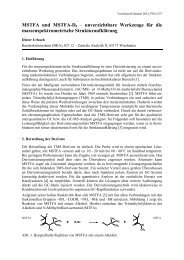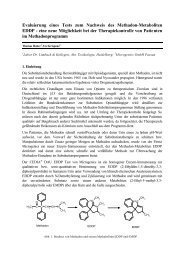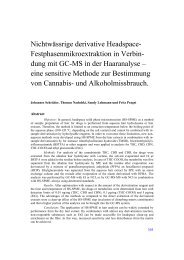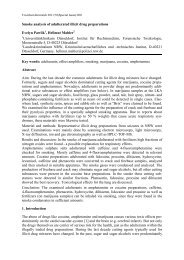In vitro UGT assay for inhibition studies of benzodiazepines ... - GTFCh
In vitro UGT assay for inhibition studies of benzodiazepines ... - GTFCh
In vitro UGT assay for inhibition studies of benzodiazepines ... - GTFCh
Create successful ePaper yourself
Turn your PDF publications into a flip-book with our unique Google optimized e-Paper software.
The results show that the K m values <strong>for</strong> S-oxazepam (28.8+/-5.3 and<br />
37.1+/-9.6 µmol) and S-temazepam (77.4+/-12.6 and 82.9+/-7.7 µmol) were<br />
lower than <strong>for</strong> R-enantiomers (R-oxazepam (90.7+/-12.6 and 104.9+/-10.6 µmol),<br />
R-temazepam (336.4+/-37.6 and 370.2+/-94.6 µmol)). The determined K m -values<br />
<strong>of</strong> R- and S-oxazepam indicating a higher affinity to the <strong>UGT</strong>-enzyme<br />
superfamily as the enantiomers <strong>of</strong> temazepam. Furthermore the measured<br />
K m -values are indicating a higher <strong>UGT</strong>-affinity <strong>of</strong> the S-enantiomers unlike the R-<br />
enantiomers <strong>of</strong> the <strong>benzodiazepines</strong> oxazepam and temazepam. <strong>In</strong>hibition <strong>studies</strong><br />
between the <strong>benzodiazepines</strong> oxazepam, temazepam and the opiates morphine and<br />
codeine as inhibitors showed that the K i -values <strong>for</strong> S-enantiomers are smaller than<br />
<strong>for</strong> R-enantiomers, which is exemplarily shown in Fig. 4.<br />
velocity(pmol/min/mg)<br />
25<br />
20<br />
15<br />
10<br />
5<br />
(A)<br />
1/velocity(pmol/min/mg)<br />
0,8<br />
0,6<br />
0,4<br />
0,2<br />
(B)<br />
velocity(pmol/min/mg)<br />
0<br />
0 50 100 150 200 250 300<br />
40<br />
35<br />
30<br />
25<br />
20<br />
15<br />
10<br />
5<br />
(C)<br />
(R,S) Oxazepam (µM)<br />
-0,010 -0,005 0,000 0,005 0,010 0,015 0,020 0,025<br />
1/velocity(pmol/min/mg)<br />
0,12<br />
0,10<br />
0,08<br />
0,06<br />
0,04<br />
0,02<br />
1/(R,S) Oxazepam (µM)<br />
(D)<br />
0<br />
0 50 100 150 200 250 300<br />
(R,S) Oxazepam (µM)<br />
-0,02 -0,01 0,00 0,01 0,02 0,03<br />
1/(R,S) Oxazepam(µM)<br />
Fig. 4: Michaelis-Menten plot (left) and Lineweaver-Burk plot (right) <strong>of</strong> R-oxazepam (A/B) and<br />
S-oxazepam (C/D) inhibited by 0 µM (-●-), 2.5 µM (-○-), 5.0 µM (-▼-), and 10.0 µM (-∇-)<br />
morphine.<br />
By using the <strong>benzodiazepines</strong> as inhibitors, temazepam showed the highest<br />
inhibitory effect on the glucuronidation <strong>of</strong> morphine, whereas oxazepam inhibited<br />
the codeine glucuronidation most. <strong>In</strong> addition, the glucuronidation <strong>of</strong> codeine was<br />
much more affected by the <strong>benzodiazepines</strong> than it was observable <strong>for</strong> morphine.<br />
168



